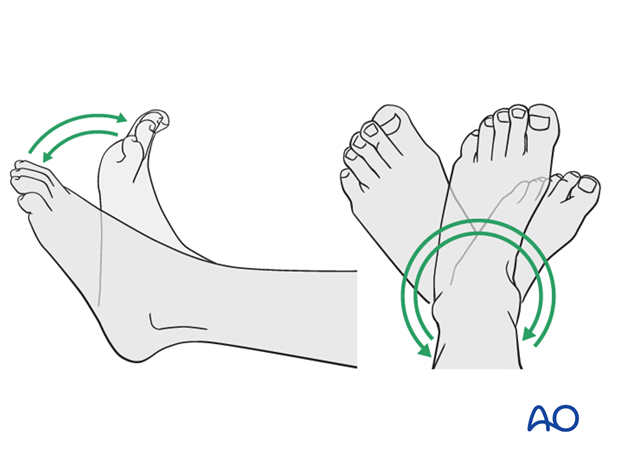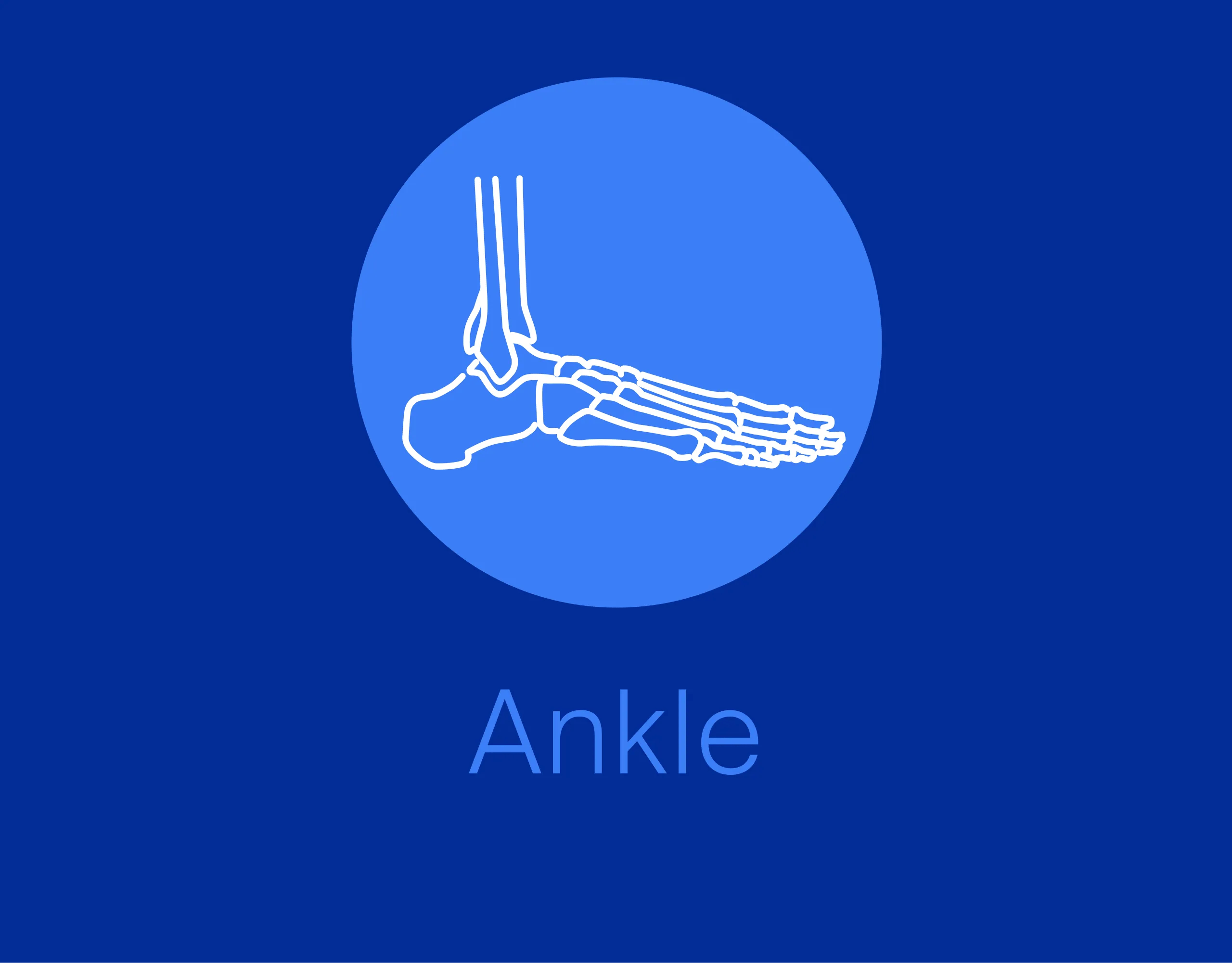MIO - Bridge plate
1. General considerations
Principles
The soft-tissue conditions usually dictate the choice of procedure: early single-stage or multiple-stage surgery. When the soft tissue damage is minimal, acute single stage MIO stabilization is appropriate.
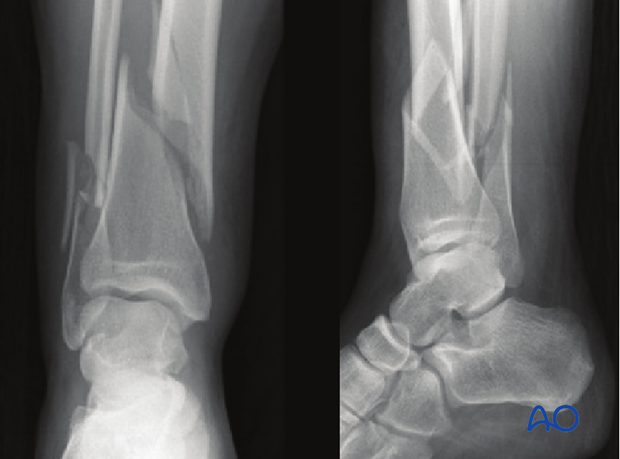
Displaced fractures with minimal, closed soft-tissue injury
(Tscherne classification, closed fracture grade 0, rarely grade 1)
These injuries may be reduced and fixed primarily, as a single stage procedure, if the soft tissues are in truly excellent condition.
A distractor or external fixator may aid reduction. Fibular reduction and fixation is the usual next step, but this reduction must be accurate, so that it does not prevent tibial reduction. Finally, the tibial plate is introduced with MIO technique and final reduction of length, alignment and rotation is achieved.
Grossly displaced fractures and/or fractures with severe, closed soft-tissue injury
(Tscherne classification, closed fracture grade 2 or 3)
It is generally advisable to proceed in two or more stages:
- Closed reduction and joint bridging external fixation
- Definitive MIO reconstruction after 5-10 days (wait for the appearance of skin wrinkles)
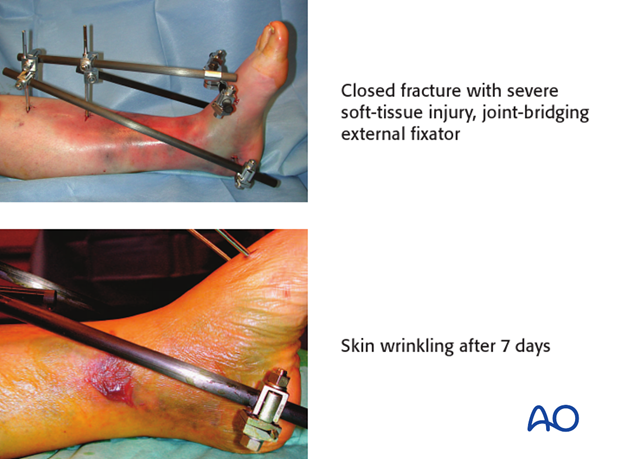
Open distal tibial fractures
These are very severe injuries which may require plastic surgery for soft-tissue reconstruction. The management includes several stages:
- Emergency management: Wound debridement and lavage. Joint-bridging external fixation and stabilization of the fibula (if needed and soft tissues allow). Where possible, closure or coverage of any opening into the joint should be achieved.
- After 48 hours: Soft-tissue coverage (local or free flap). Plan for definitive stabilization at this time.
- Definitive stabilization: Bridging of the metaphyseal comminution, with or without bone graft.
Bone grafting at the time of soft-tissue coverage is possible if the envelope is obviously viable but in marginal soft-tissue situations or in the multi-traumatized catabolic patient bone grafting as a secondary procedure may be advisable.
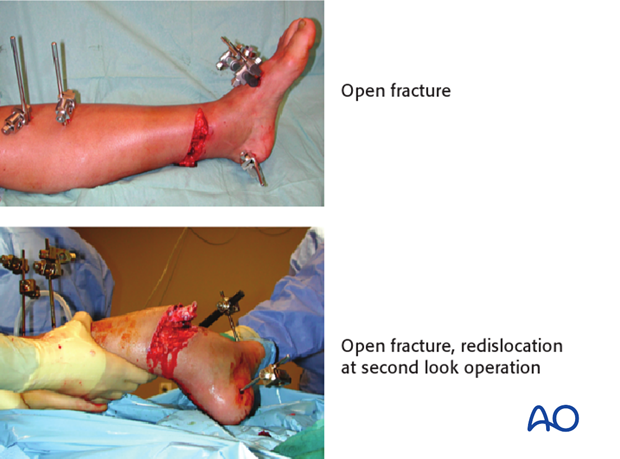
Teaching video
AO teaching video: Distal Tibia - Percutaneous Plating - LCP Distal Tibia Plate
2. Fibula or tibia first? Sequence of bone stabilization
Introduction
If the fibula is fractured, it usually needs to be stabilized.
Simple fibular fractures
This fracture is usually addressed first with open anatomic reduction and plate fixation. Alternatively, for transverse fractures, consider a small diameter, flexible intramedullary nail. Fibular reduction helps realign the tibia fracture.
Multifragmentary fractures of the fibula
Some fibular fractures are complex, and reduction may be difficult. Any malreduction of the fibula will impede anatomic reconstruction of the tibia. In this situation, fibular ORIF is better performed after the tibia has been fixed. The syndesmotic ligaments are usually intact, so gross realignment of the fibula occurs with reduction and fixation of the tibia. For comminuted fibular fractures a MIO technique with a long bridging plate, or intramedullary fixation of the fibula with a small diameter, flexible nail is easily achieved after tibial reduction and fixation. Fibular nailing is particularly applicable if the soft-tissue injury or complexity of the fracture makes extensive exposure for internal fixation hazardous.
3. Preoperative planning
Preoperative planning is an essential part of treatment of all distal tibial fractures. It consists of:
- Careful study of the x-rays
- Drawing of both the fracture fragments and the desired end result (often indicated by a reversed tracing of the intact opposite tibia)
- Consideration of intraoperative reduction techniques, including switching to open reduction in case indirect reduction is unsuccessful
- Choice of implants
Reduction can be achieved by ligamentotaxis alone with indirect manipulation. Direct exposure is therefore not often necessary. The shape of the implant serves as a reduction tool. A properly contoured plate applied according to a good preoperative plan improves your chances of a good reduction.
Implant choice and plate contouring
With MIO plate constructs it is preferable to choose as long as possible an implant for the widest distribution of load at the fracture site.
A variety of precontoured distal tibial plates are available.
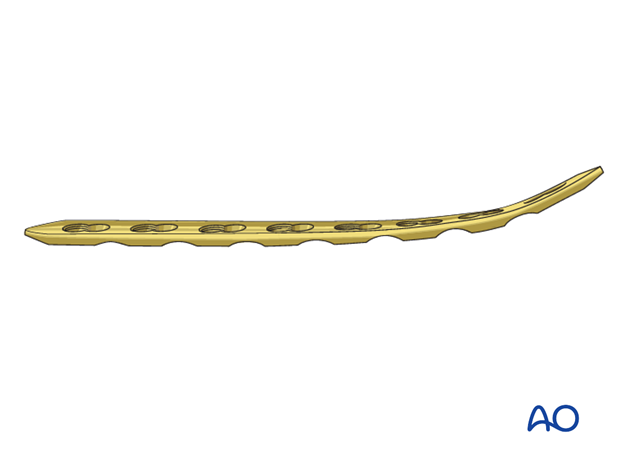
If such an implant is not available, it is important to precontour the plate prior to insertion. A 3.5 or occasionally 4.5 mm standard or locking plate (LC-DCP or LCP) can often be used, but distal purchase may be compromised without a specially designed plate. For distal fractures and osteoporosis, locking head screws (LHS) may be more stable distally.
A non-contoured plate can be shaped prior to sterilization, using a sawbones model as a template. First, determine the length of the plate from preoperative x-rays. Remember that the plate must be twisted to fit the distal tibia. As illustrated, the medial tibia distally lies closer to the sagittal plane while the shaft rotates externally above the metaphysis.
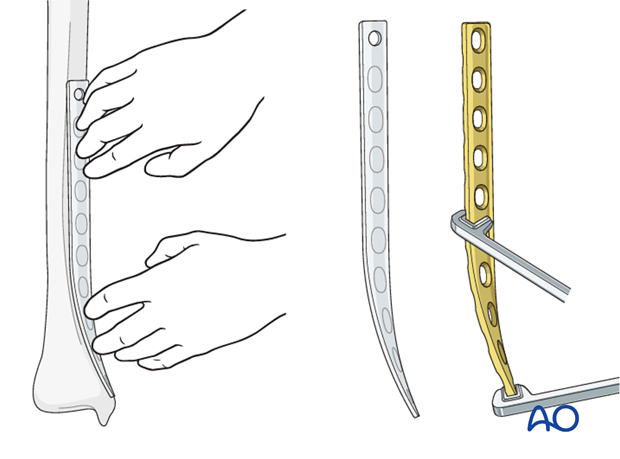
4. Patient preparation and approach
Patient preparation
This procedure is normally performed with the patient in a supine position for MIO.

Approach
For this procedure a minimally invasive approach is used.
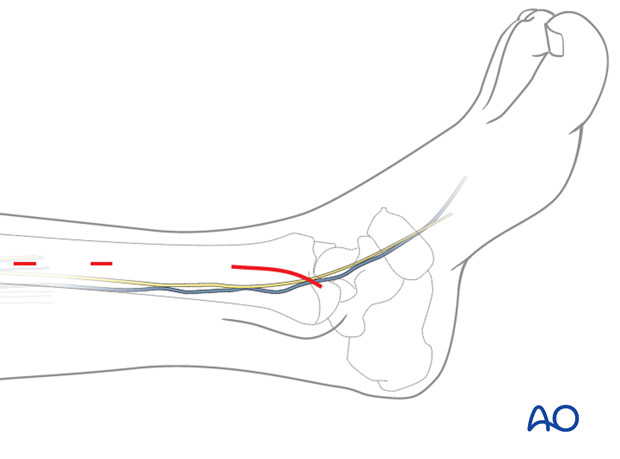
5. Preliminary reduction
Indirect reduction with a distractor
An appropriately positioned distractor or external fixator is a very helpful tool for reduction, especially for length and rotation.
Medial positioning allows subcutaneous access to the tibia. A laterally based distractor requires a pin through the anterior muscular compartment but provides more efficient distraction of any associated fibular fracture, and correction of valgus deformities. Distraction can be used for the open reduction and plate fixation of the fibula as first step (if not already fixed) and for the reduction of the tibia as a second stage after previous fibular stabilization.
Schanz screws are positioned in safe zones of the tibial shaft and talar neck (or the calcaneal tuberosity). In case of previously applied joint-bridging fixator, the already existing Schanz screws can be used.
The final reduction occurs during plate application.
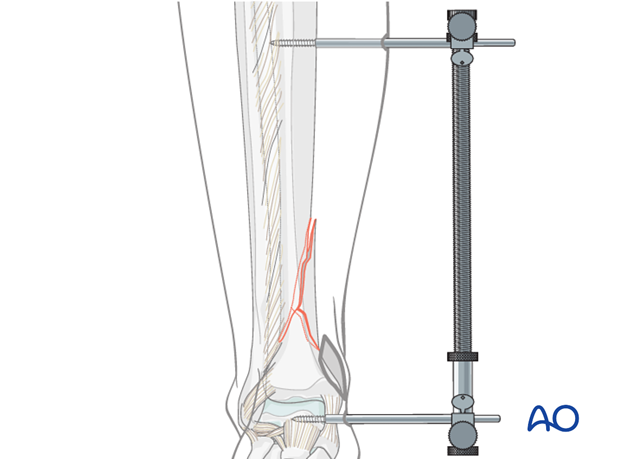
6. Plate insertion and final reduction
Tibial length and rotation are restored indirectly with distractor or external fixation. Angulation may be approximated in the same way but is definitively corrected by plate application.
The plate is inserted after proximal tunneling with a blunt instrument.
Depending on the fracture situation, the plate is usually positioned on the anteromedial aspect of the tibia.
Proximally, above the fracture zone, a small incision (2-3 cm) will aid plate positioning. It is important that the plate and proximal screw be centered on the tibia, particularly if locking screws will be used.
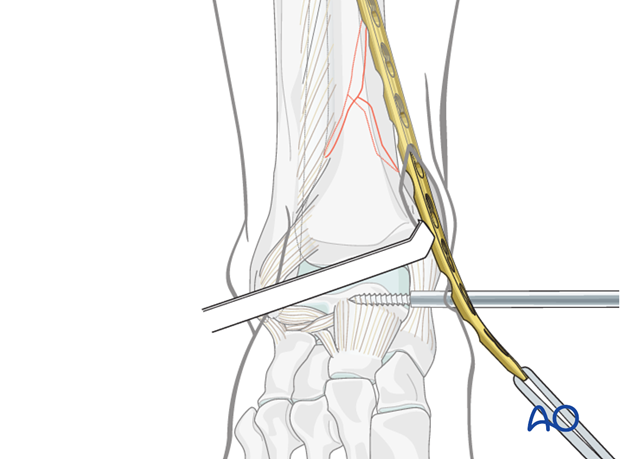
7. Preliminary plate stabilization
Temporary fixation can be performed with K-wires through the screw holes (or inserted drill sleeves) to approximate the final plate position before screw insertion.
Make sure the plate is positioned to fit the properly reduced distal segment. If the position is satisfactory, provisionally fix the plate to the proximal segment with a single conventional “positioning” screw through the plate. This screw brings the plate and bone together.
Assuming the plate is properly contoured and positioned, fitting the distal tibial segment to the plate will complete fracture reduction. A conventional screw can be used to draw plate and bone together to achieve the final reduction distally (see also the content on assessment of reduction).
Subsequently, locking head screws (LHS) may be inserted into the reduced distal fragment.
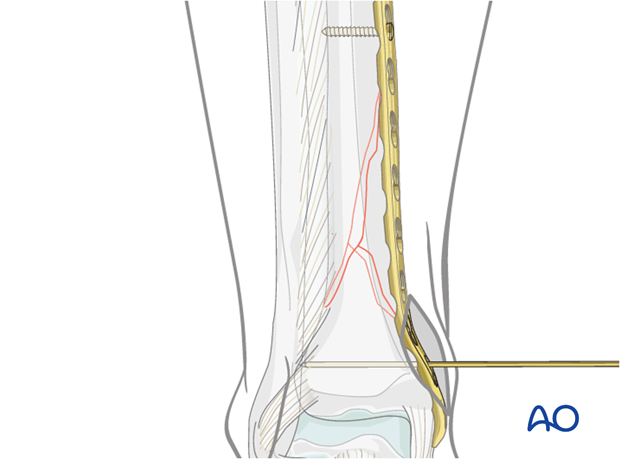
Pitfall - Malpositioning of the plate
If the plate is not positioned correctly, there is a danger of missing the bone with proximal screws or placing them only in one cortex.
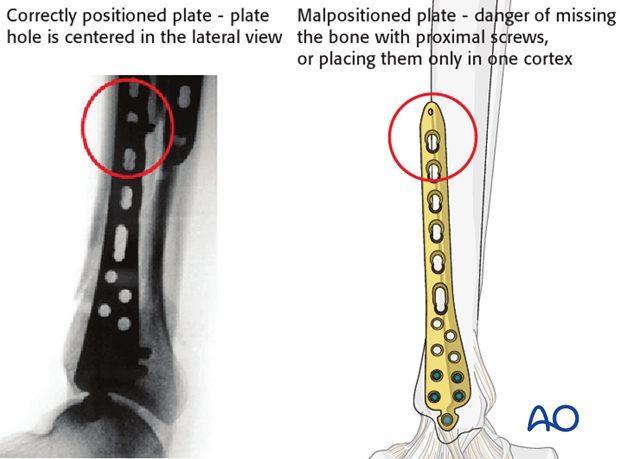
8. Plate fixation
Accurate screw positioning
Further proximal and distal screw insertion is now completed. It is advisable to formally expose the proximal end of the plate to ensure accurate screw positioning.
The number and position of the screws inserted depends on the specific fracture pattern. The goal is “balanced fixation”. This means roughly equivalent fixation strength in both proximal and distal segments. Usually, the metaphysis requires more screws (3-5) than the diaphysis (2-3). Cortical bone provides better screw purchase than cancellous bone.
In osteoporotic bone, the number of screws should be increased, particularly in the cancellous distal segment.
Note that a single conventional screw, with lag technique, passes through the wedge fragment, and into the distal lateral spike of diaphysis. This compresses a large wedge fragment between plate and diaphysis, improving fracture stability.
Bone grafting is almost never required, except in open extraarticular fractures with bone loss. In such cases, it should be delayed until the soft-tissue envelope is stable.

Fixation of the fibula
In most cases, the fibula is fractured as well and needs to be stabilized. Multifragmentary fractures of the fibula are better addressed after stabilization of the tibia (see also considerations in step 2).

Wound closure
Atraumatic skin sutures are used for closure of screw insertion wounds. Occasionally, additional deeper sutures are needed for distal and proximal incisions.
9. Final assessment
The x-ray imaging at the end of the operation confirms the anatomical restoration of length, alignment and rotation (see the content on assessment of reduction).
10. Aftercare following plating
Leg elevation is recommended for the first 2-5 postoperative days. Physiotherapy with active assisted exercises is started immediately after operation. Immobilization is not necessary.
Mobilization
Starts depending on the wound healing with flat footed, weight of the leg weight bearing (10-20kg).
Follow up
Clinical and radiological follow-up is recommended after 2, 6 and 12 weeks. Depending on the consolidation, weight bearing can be increased after 6-8 weeks with full weight bearing usually after 3 months. Supervised rehabilitation with intermittent clinical and radiographic follow-up is advisable every 6-12 weeks until recovery reaches a plateau, typically 6-12 months after injury. Weight-bearing radiographs are preferable to assess articular cartilage thickness. Angular stable fixation may obscure signs of non-union for many months.
Implant removal
Implant removal may be necessary in cases of soft-tissue irritation by the implant (plate and/or isolated screws). The best time for implant removal is after complete remodeling, usually at least 12 months after surgery.
